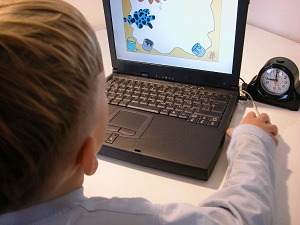Using Technology for Teaching

 The biggest benefit of using technology for teaching and learning is that digital media improves that which we are able to know and do. So, do we make up multiple presentations of the same content—using text for some, speech for others, and images for still others?
The biggest benefit of using technology for teaching and learning is that digital media improves that which we are able to know and do. So, do we make up multiple presentations of the same content—using text for some, speech for others, and images for still others?
This just isn’t very feasible. Collecting and maintaining a sufficiently varied assortment of media that would allow us to create an optimal instructional environment for every student in every unit of curriculum would be incredibly costly, consume too much space, create grand logistical problems and quite frankly, drive teachers insane. Furthermore, this is not realistic. Teachers don’t need more tools; what we need are better tools!
Linking one piece of digitally stored content to another helps us in using technology for teaching and learning through access to reference materials, dictionaries and almanacs, as well as guides supporting reading comprehension, supplementary content that builds background knowledge, electronic notepads and visual organizers.
Digital media makes it possible to move quickly between a word and its definition, an image and its description, a video and a review, or a text passage and an audio file. And, this is all possible without the World Wide Web.
As schools often have security restrictions on their Internet access that prevent users from access to certain websites, it is very useful for teachers to think of the ways to use digital media without the connection.
What are some of the ways you have been using technology to support learning in your classroom?
From Professional Learning Board’s online continuing education course for teachers: Accommodating All Learners




Digital media most definitely helps students synthesize their knowledge to create a “final exhibition” to share with their peers and parents. There are so many wonderful programs for students of all ages for students to “create” a poster, a slideshow, a graphic cartoon to show what they have learned in literacy and social studies, literacy and science…Digital media allows students to integrate their knowledge and create a presentation that they are proud of. Digital media is another way for students to shine and show what they know, creatively.
Digital media also helps students practice their math skills, their literacy skills, etc. There are so many differentiated sites to choose from that matches each child where they are now, and move them forward, and they have fun working hard. When there is only one teacher, differentiated sites help the teacher reach every individual student for a full 45 minutes of Computer Lab time! Reading programs for young students help students read at their level and help them “hear” stories with expression and fluency as the words are highlighted. Many programs have “quizzes” that help track students’ comprehension.
Digital media provides the visuals so children can “see,” and read to gather research for future projects. Digital media helps children create graphs and tables using important data. Digital media provides the variety of sources that students need to learn. For me, personally, digital media is the “hook” to motivate students to work hard and sharpen their skills across the curriculum, and create “final exhibitions” they can be proud of.